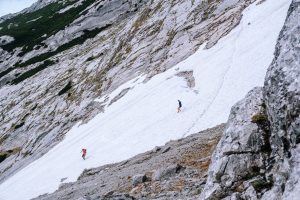The temperatures are finally like early summer, the hiking season has finally started after a cool spring. But despite the lack of snow in the winter, the last remnants of avalanches are still lurking on some hiking trails in the mountains.
The risk of falling on the hard-frozen and often steep snow surfaces is high, as several tragic accidents have already shown. The Austrian Alpine Association recalls the right measures that mountain hikers can use to safely cross old snow fields.
Old snowfields are treacherous and easily hold up well into July. If sections of the trail are buried under them, hikers face an obstacle. "Crossing the snowfield with a few wobbly steps and moving on - this approach often leads to serious accidents like on the Kitzbüheler Horn," warns Michael Larcher, head of the mountain sports department at the Alpine Club.
After just a few meters, sliding down a 35-degree firn slope, you reach speeds that you can no longer control. Even a less steep slope is sufficient for critical situations. “The old snow fields are often frozen hard. Once you start slipping, you can hardly stop on the icy surfaces. Even if they don't seem so steep at first glance," explains Larcher.
How can the risk of falling be minimized?
If a hiking trail crosses a steep old snow field, this could be a good reason to abandon a mountain tour. Alarm bells should be ringing if the snow surface is very hard, steep or if there is no well-trodden track. If the hike continues and no detour is possible, there are some safety recommendations to consider. "So that you can actually take steps when crossing a snowfield, at least the top ten centimeters of the snow cover should be softened," recommends mountaineering expert Larcher, adding: "Good mountaineering boots are an absolute must."
An upright posture is also beneficial, with your hips slightly bent in and your center of gravity over the downhill shoe. Hiking sticks help to maintain balance, but cannot prevent slipping. For this reason, Michael Larcher recommends so-called snow spikes: “These can be pulled over any hiking boot like snow chains. They are ideal for crossing snow fields safely. Spikes are light and can easily be taken on mountain tours.”
Got stuck - what to do?
In snowy areas where there is a risk of slipping, it is advisable to be fully clothed and to wear gloves. Anyone who slips on an old snow field must immediately try to stop the fall by any means necessary. Michael Larcher says, "If you slip, it's important to immediately turn onto your stomach and brake in the push-up position with your arms and legs." This action can save lives before the slide speeds up and becomes uncontrollable.
Careful planning
Depending on the orientation, the conditions on the mountain slopes also vary. The Alpine Club therefore advises hikers to find out about the current conditions before each tour. Local webcams and specialized tour planning apps such as alpenvereinaktiv.com, which has been offering a digital snow depth map since this season, offer an up-to-date overview of the snow conditions on the planned tour. Particular caution is required on excursions with children: snowfields are only a suitable playground if they have a moderate incline and a gentle run-out that does not have any stones.
Well prepared with the video series "Safe mountain hiking"
In order to be as well prepared as possible for alpine dangers when hiking, the Austrian Alpine Association recommends its video series "Safe mountain hiking". The video "Caution, old snow fields!" shows all the tips on the right technique and, in particular, the right equipment when crossing old snow fields.




